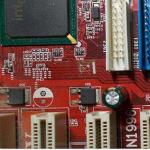Battery for laptop motherboard cr2032. BIOS battery on computer motherboard
Many novice users, when you tell them that they need to change the battery, begin to get scared and doubt that they can do it themselves. As if this battery is somewhere far away and in order to replace it you need special education.
In fact, everything is much simpler and you will see this by reading this article, you will learn what kind of battery is needed for the motherboard and how to replace it.
Modern motherboards use a CR2032 3v battery. This is exactly the label you need to ask for in stores when purchasing it. The fact is that in nature there are several batteries that may be suitable in their characteristics for powering the motherboard, although this can be said with a stretch.
Here are examples of such elements:
CR2016 – diameter 20mm, thickness 1.6mm, 75-90mAh;
CR2025 – diameter 20mm, thickness 2.5mm, 150mAh;
CR2032 – diameter 20mm, thickness 3.2mm, 210-230mAh;
As can be seen from the example, their markings are their sizes, so remembering the right one will not be difficult. The first two numbers are the diameter in millimeters, the last two are the thickness: 32-3.2mm, 25-2.5mm. CR2032 is the thickest of them, the rest will not fit well into the motherboard connector, you will have to bend the contacts or put something under them.
If we talk about their capacity, then CR2032 has the largest 210-230mAh, which means that it will last for a long time (several years).
The main job of the battery in the motherboard is to maintain the CMOS settings when the power is turned off. These are settings such as the order in which disks and drives are loaded, memory and processor frequencies, time and date settings, etc.
If the battery runs out and you turn off the power to the computer, then all the settings will return to the factory settings and if you changed them, you will have to configure everything again.
If you haven't turned on your computer for a long time or rarely use it, the battery will run out faster than if you keep it on all the time. But this is not a reason not to turn off your PC, just keep it in mind.
The computer always informs the user about problems if it finds them, and so it is in this case.
For example, if you see the message:
“CMOS checksum error – Defaults loaded”
This is one of the signs that it is time to change the battery.
Also, the user will be prompted to change the battery by the following messages:
CMOS battery low failed
CMOS battery failed
The type of message depends on the BIOS manufacturer.
Also, the simplest sign for the user that the battery is low is that when you turn on the computer, the time and date are constantly reset, and they have to be constantly adjusted.
Changing the battery is very simple for any user who would like to. It is very easy to find; it is a flat battery with a diameter of 2 cm, which is located at the bottom of the motherboard. There is only one, so it is impossible not to find and mix it up.
Before removing the battery, completely disconnect the computer from the network to avoid short circuits.
It is better to reset the BIOS than to buy a new motherboard.

Gennady | September 22, 2016, 07:57
Debunking that CR2032 is a battery.
The fundamental differences between disposable non-rechargeable batteries and rechargeable and rechargeable reusable batteries.
All galvanic non-chargeable cells (commonly called batteries) have a voltage of 1.5 Volts (indicated on the case) and have exactly one element, and have a sealed case. Also on the case is indicated the standard size AA or AAA, which means finger or little finger. Also on the body they write Alkaline, that is, alkaline, which means alkaline. If this word is not present, then the battery is salt.
All battery elements have a voltage of 1.2 Volts (indicated on the case) and exactly one element, and have technological holes in the case for exhaust gases (carbon dioxide) to exit the battery during the charging and discharging process of the battery. Also on the battery case the composition of the chemical filling of the battery is indicated: Ni-Cd, Ni-MH, Li-Ion.
The CR2032 battery has an operating voltage of 3 Volts, these are two elements of 1.5 Volts each and has a sealed case. If the CR2032 were a battery, it would have a voltage of 2.4 Volts consisting of two cells, or 3.6 Volts consisting of three cells. Typically there are 3.6 volt battery packs. If you try to charge disposable batteries, of course, at the first moment the voltage in them will rise and they will charge a little, but this little will be enough, just for a little bit, whack and there’s no charge. And since the batteries have a sealed case and do not have technological holes in the case for exhaust gases to escape, then during a long attempt to charge the case may swell, or worse, the battery may explode, and in the best case, electrolyte will leak from the battery which can ruin the device which contains the battery.
Explanation of CR2032 marking:
CR - galvanic non-rechargeable cell,
2032 - dimensions of the element, where 20 is the diameter in millimeters, 32 is the thickness in millimeters.
There are CR2016, CR2025, CR2032 of different thicknesses, respectively, batteries of different capacities, cheaper and more expensive.
However, there are also batteries similar to CR2032 batteries. These are ML2032. On its body it says Rechargeable, which means rechargeable.
So we have:
CR - galvanic non-rechargeable cell, battery
ML - rechargeable and multi-rechargeable battery
As for personal computers and motherboards for computers on which a CR2032 battery is installed. Why do the batteries last so long? The CR2032 battery is installed on the computer's motherboard to maintain the clock and BIOS settings while the computer is completely unplugged from the power outlet. When the computer is turned off and not working, but power is supplied to it from the outlet, a small current is supplied to the motherboard from the standby voltage of the computer's power supply side, which works instead of the battery, and the battery does not come into operation and is not wasted. It turns out that although the computer is turned off and does not work, it seems to be partially working; there is a weak power supply in the power supply called standby voltage. But if the computer is completely unplugged from the socket, then the battery comes into operation and keeps the BIOS settings and the clock and system date up to date when the computer is completely unplugged from the socket and begins to be wasted. For those who like to turn off the computer completely from the outlet, for example, as a pilot, the battery lasts 2-3 years. For users who do not completely turn off the computer from the outlet, the battery lasts for 10 years or more. It is also taken into account that CR2032 batteries have a very small, practically no self-discharge current. The motherboard itself technically does not provide for recharging the CR2032 battery inserted into it.
Philosopher | 16 July 2016, 15:12
Gentlemen, you are not entirely right. Almost any battery is “reversible” to one degree or another, since when applying electricity. charge current most chemical equations. reactions that give electricity when the battery is running simply starts working in the “opposite direction”. The problem usually arises from the fact that when designing and constructing a “battery”, in order to reduce the cost and simplify the design, they usually do not pay attention to a number of problems: decomposition of the electrolyte by the charging current, drying out, or gas formation (which is very important for sealed, maintenance-free batteries). As a result, an attempt to “charge the battery” ends in “zilch” in the literal sense of the word. And in the case of a lithium battery, due to the formation of metallic lithium during charging and depressurization of the case from inflation by gases, the latter also ignites (often with burns to the hands or face of the experimenter).
A BIOS battery is usually a tablet running on lithium-manganese oxide pair (lithium + manganese dioxide) working 3V. A lithium-ion battery operates on a pair of graphite + lithium ions bound in a liquid organic polymer and has an operating voltage of ~3.6V, so they are NOT directly interchangeable. Trying to install in the mat. such a battery will most likely damage the north bridge of the board. However, nothing prevents you from using two 1.5V alkaline cells connected in series. Or any two one-and-a-half-volt batteries (say, nickel-cadmium). Of course, instead of a “tablet,” you will need to insert an adapter into the socket with wires connected to the battery pack and add a charging circuit from the 3.3V line of the computer’s power supply, say, through a resistor voltage divider or a stabilizer on a microcircuit. The downside is the high self-discharge current (alkaline batteries lose about 20% of their charge per month).
Kulibin | 18 June 2016, 13:22
Everyone should read 6th grade Physics - Soviet edition!!!
Ivan | 3 May 2016, 20:43
One of the reasons for the confusion in the terminology of chemical power sources is that, due to the twenty-year perestroika “rest” of domestic science, it is necessary to use foreign technical literature translated into Russian. And there the word “battery” reigns, both for galvanic batteries and for small-sized batteries. And to be sure, you have to look for the word “richable” or “know richable”.
VALDEMAR | 28 February 2016, 17:54
I tried it - it charges perfectly! You just have to be careful with the current. I bet 5 ma.
Grigoriev | November 5, 2013, 11:19
Vitek, your old element simply overheated. So he “gave” you tension. Don't worry, it will soon lose voltage and you will be convinced that it is not a battery, but an ordinary chemical battery. And for “decades” these batteries do not work. Someone deceived you.
Vitek | 3 November 2013, 21:21
The battery in the computer is a lithium-ion battery; it is recharged when the computer is plugged in (and voltage is applied to the motherboard). Otherwise, there is no way she could have worked for decades. Sometimes the battery discharges very strongly (in computers or motherboards that have been lying around for many years without use).
I recently took a 7-year-old motherboard out of the closet for a home server, took out the battery and applied 15 V to it at a current of 10 mA. After a couple of hours, the voltage on it was 2.6 V. I inserted it into the motherboard - everything works. A few months later I checked - the battery had 3 V, which means it was recharged during this time!
Dodik | June 1, 2013, 11:31 pm
Charging? It depends on how you look at it. When power is applied to the battery, resistance results in heating of the element, and accordingly acceleration of the chemical reaction. reactions. As a result, its charge increases, but not for long; the same effect can be seen by placing any battery in a warm place). Conclusion, battery charge is a twofold concept, it seems to be yes, but at the same time, no).
Lena | October 26, 2012, 11:07
Nikita! There are no “soft hints” here - this is a lithium galvanic cell with a voltage of 3 volts, it is not rechargeable, and if it fails (discharges) it cannot be restored. Such elements do not have self-discharge, and if the manufacturing technology is followed, the service life is at least 15 years (as part of a working PC).
It does support the memory (BIOS) of the PC, but it does not consume any current at all (vanishingly low consumption (less than 0.5 µA) is only for running the clock when the PC is turned off). Shorter service life means:
a)unscrupulous manufacturer;
b)poor quality watches.
Batteries of this standard size exist, but are not used in PCs. They have a voltage of 4-4.4 volts; if desired, they can be picked out from one type of Chinese flashlight keychain with solar recharging. The solar cell there is just a decoration; it is completely ineffective, but by charging the battery from an external source, it can still be used (including in a PC). Very old PCs also had rechargeable alkaline (three-cell) batteries. Although the consumption of the watches of that time was greater, due to recharging the service life was also more than 10 years and they were sealed into the board.
As for terminology, a “battery” is a series (compound) of similar elements united for a common task. Wed, artillery b., or “battery of bottles..” However, in established Russian jargon, the diminutive “battery”, as a rule, means a single galvanic cell, “battery” - a connection of several, “accumulator” - a rechargeable element, “battery of batteries " - a connection of several rechargeable elements.
Today we’ll look at the topic How to determine if the BIOS battery is dead. Let's begin.
It's hard to imagine, but running out of one small battery can seriously disrupt your computer's performance. When BIOS battery runs out, the computer begins to crash and glitch, and then stops turning on altogether. To prevent this, it is necessary to notice all the symptoms of a dead battery in time and promptly replace it.
- The surest sign that the battery needs to be changed is a constant failure of the time and date in your operating system. This happens because the BIOS is responsible for the time and date on the PC. And if the necessary recharge in the form of a battery is depleted, it ceases to correctly calculate the time and date and resets them to the original parameters the next time it is turned on.
- The settings began to change to standard. Even if you have never entered the BIOS settings, you can easily notice this - when you boot your computer, an inscription will begin to appear on the screen containing the phrase “ CMOS checksum error", and a proposal to reconfigure your BIOS.
- The computer begins to seriously slow down, restart spontaneously or even turn off for no reason, and stops loading any applications or drivers.
- Some computers have a battery sensor on the motherboard. If it starts to sit down, the sensor warns the user about this when the PC is turned on.
- The computer stops turning on altogether, that is, it does not respond in any way to pressing the power button.
Remember that the third and fifth symptoms separately may not relate to a dead BIOS battery. However, it is better to start checking with it.
Helpful Hint: If you have a multimeter or voltmeter, you can check the voltage on your battery. To do this, remove it from the motherboard, having first disconnected the PC from the power supply, and measure the voltage. If it is much less than 3 V, then it is time to change the battery.
Where is the battery located and what does it look like?
The BIOS battery is located on the motherboard, in a special connector. It is round, almost flat, with a diameter of several centimeters. Usually it’s easy to pick it up with something sharp and pull it out.

Where to buy a BIOS battery
Such batteries are widely sold in departments with batteries and accumulators, as well as in any computer store. you can ask CR2032 battery or, without bothering too much, a BIOS battery. They will definitely understand you.
Price for one battery – from 20 to 60 rubles.
How to replace the battery
This is not difficult to do. Even for a person who is not particularly familiar with computers. You will need a standard Phillips screwdriver and a new battery CR2032.
- First, completely disconnect your computer from the network;
- Then remove the side panel of the system unit using a screwdriver;
- Find the battery on the motherboard, carefully pick it up and pull it out;
- As quickly as possible (so as not to reset the BIOS settings), insert a new battery;
- Put back the side panel, connect the PC to the network;
- If the BIOS settings are still lost, reconfigure the BIOS.
Not so difficult, right? This small and very useful knowledge will save you money on a computer technician. The battery can be replaced in 5 minutes. And this simple action can significantly improve the performance of your





